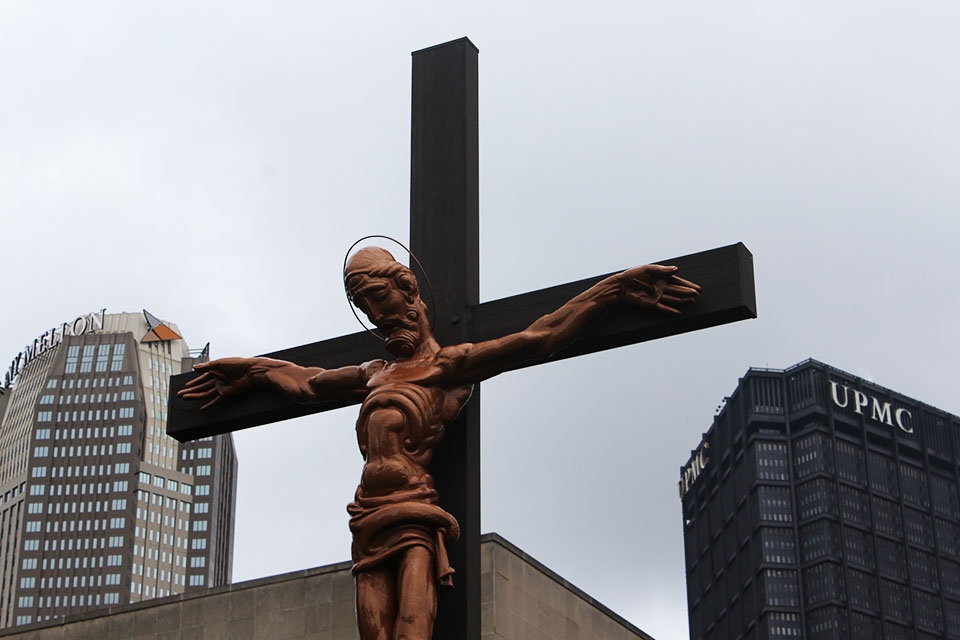
Krystina Primack | Staff Writer
03/22/2018
As Easter approaches, we are reminded that this time of year provides an opportunity to consider how Duquesne University, a Catholic institution, welcomes and serves students from different faiths and cultural backgrounds. This includes the role that religious iconography plays in producing meaning in the lives of students who may or may not be Catholic.
The most prominent icon here at Duquesne are the crucifixes, which is important in Catholicism as it focuses adherents’ attention on Jesus Christ’s ultimate sacrifice.
Through interviews with students and other members of our university community, this three-part series will explore the meanings of the crucifixes at Duquesne. This series will also focus on a variety of representations of crucifixes here, including Jose Pirkner’s lovingly-nicknamed “Scary Jesus” interpretation in the courtyard between Rangos Health Science Building and Rockwell Hall, as well as other notable crucifixes throughout the campus.
Duquesne University was founded by members of the Congregation of the Holy Spirit, or the Spiritans, but it has grown to foster a student body composed of people from diverse backgrounds. Although Catholic iconography factors largely into the landscape of our campus, it is also notable that Duquesne’s mission statement emphasizes that this is an equimenical institution and therefore welcomes and represents a wide variety of religions beyond Catholicism.
In fact, part of the mission statement asserts that the university is “sustained through a partnership of laity and religious. Duquesne serves God by serving students through … [maintaining] an ecumenical atmosphere open to diversity.”
From one student’s point of view, the prominence of the crucifix is very much a part of Duquesne’s identity. When asked what she thinks about religious iconography displayed here, Lindy Nebiolo, a freshman international relations and history major said, “I think seeing as we’re a Spiritan Catholic college, it’s pretty reasonable that there’s a lot of iconography throughout the campus as a whole. However, Duquesne has done a good job at allowing diversity, such as the prayer room in Fisher for people of differing beliefs, not to mention the diverse religious groups represented as clubs on campus. I myself don’t hold a particular view positive or negative. For me, it’s just another aspect of our campus culture.”
Another student shares much of the same sentiment. Claire Novak, a senior English major said, “The appearance of religious symbols does seem to contribute to a unique atmosphere on campus that is characteristically ‘Duquesne,’ and they certainly draw attention to the university’s history and its mission statement.”
Duquesne’s diversity statement highlights this idea by saying, “[Our] commitment to inclusive excellence encompasses every aspect of personhood — including age, citizenship, disability, ethnicity, gender, race, religion and sexual orientation.”
Novak also said, “Brought up in a Christian family, I definitely don’t experience any discomfort seeing crucifixes in our classrooms and across campus,” said Novak. “It is imperative, however, that we also acknowledge that there are many [students, faculty and staff] with different backgrounds who share those spaces, and that their comfort is just as important.”
She continued by noting, “You do find a lot of Catholic students on campus … but you also find students with
countless other unique backgrounds. So although I do believe there is a greater concentration of Catholic students than you would find at other universities of our size, we aren’t strikingly lacking in diversity either.”
To that end, we see that other religions are represented by their respective organizations, including the Hillel Jewish Students Organization and Chabad at Duquesne, the Muslim Students Association, as well as other such organizations for various Christian denominations, such as the Orthodox Christian Fellowship, Crossroads Christian Fellowship and Circle K International.
Beyond providing community and support for students, these organizations greatly contribute to the Duquesne’s welcoming and supportive atmosphere. For example, the Campus Link page for Hillel Jewish Students Organization says, “The purpose of [this organization] is to provide Duquesne students with social action, educational, social, cultural and interfaith activities at Duquesne University.” Similarly, the Muslim Student Association’s Campus Link page says that it, “is dedicated to promoting awareness about Islam and tolerance within the Duquesne community of all faiths and cultures.”
When considering these examples of acceptance, diversity and student interpretations alongside the crucifixes itself, we can see that it represents all students on campus, but in many different forms.
For adherents of Catholicism, it takes on a deeply personal meaning. For other students, it remains a symbol and reflection of the unique history and Spiritan traditions of Duquesne University.
Now that we understand this aspect of our institution’s relationship with the crucifixes, we can apply that context to the second part of this series, which will highlight Jose Pirkner’s statue. Then, to conclude, we will explore the importance of other notable crucifixes on campus, and what they mean to others in the community.




